Some birds have supercilium – also known as eyebrow – a stripe that runs from the base of the bird’s beak (bird’s loral area), above its eye, and ends towards the back of the bird’s head.
A bird book called “Sibley Field Guide to Birds of Western North America” mentions certain types of head markings on birds as “eyebrows.” Those eyebrows can be thin, thick, curved, or straight.
Bird eyebrows do not have a purpose to keep the debris out, as they do in other animals. Nonetheless, these plumage features are easy to notice and can be useful in bird identification.
The list of birds with eyebrows includes the King of Saxony bird-of-paradise with extremely long eyebrows, White-browed Wagtail, double-crested cormorant, funny-looking macaroni penguin, Red-browed Finch, and many others.
Let’s see the full list of such birds, show what their brows look like, and give some fun facts about them.
Table of Contents
Birds With Eyebrows
The King of Saxony bird-of-paradise

Scientific name: Pteridophora alberti
Lifespan: 5-8 years
Wingspan: n/a
Eyebrows (supercilia): Very long and blue-white (up to 20 in)
Found In: New Guinea
The King of Saxony bird-of-paradise is an incredible bird that has two very long (up to 20 in) scalloped, enamel-blue eyebrow-looking plumes.
The eyebrows are flexible and the bird can raise and lower them at will. Males tend to move them around while they are singing.
The King of Saxony bird-of-paradise is a medium-sized bird, a member of the bird-of-paradise family, and an omnivore that feeds on small insects and fruits.
The male’s head plumes are so bizarre that, when people first brought it to Europe, it was thought to be fake.
The King of Saxony bird got its name as a tribute to King Albert of Saxony; the natives of Papua New Guinea referred to it as “Kiss-a-ba”, an interpretation of the male’s loud call.
White-Browed Wagtail
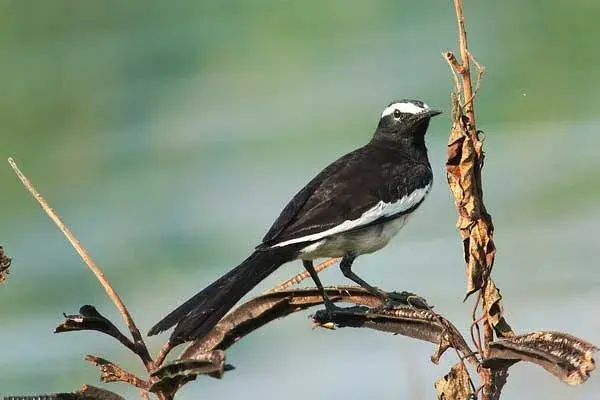
Scientific name: Motacilla maderaspatensis
Lifespan: 2 years
Wingspan: 12 in
Eyebrows (supercilia): Broad and white
Found In: Indian subcontinent
The white-browed wagtail, also known as the large pied wagtail, is a medium-sized bird with prominent broad white eyebrows. It has a black head, back, upper tail, and white underparts.
The white-browed wagtail is a slender bird with a characteristically long and constantly-wagging tail.
It can be found in open freshwater wetland habitats. Just like other wagtails, white-browed ones are insectivorous and feed on beetles, dragonflies, small snails, spiders, worms, crustaceans, and flies.
It got its scientific name from the Indian city of Madras (now Chennai). People used to keep white-browed tails as caged birds due to their amazing looks and singing abilities.
Bananaquit
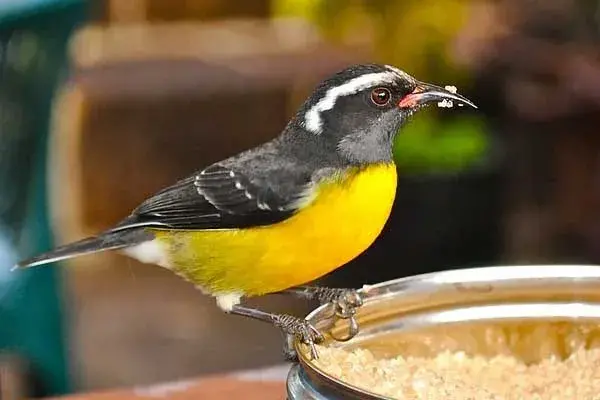
Scientific name: Coereba flaveola
Lifespan: 7-8 years
Wingspan: 7.5 in
Eyebrows (supercilia): Very long and yellow in youngs; white in adults
Found In: Central and South America
Bananaquits are distinctive birds with down-curved bills, black upperparts, and broad yellow-white eyebrows. Juvenile bananaquits have partially yellow eyebrows while the adults have them white.
They cannot hover like a hummingbird, and must always perch while feeding.
Bananaquits have a banana-yellow underside, and the name comes from their fondness for ripe bananas. Their nickname, sugar birds, comes from their love for bird feeders that are filled with granular sugar.
White-Throated Sparrow

Scientific name: Zonotrichia albicollis
Lifespan: 9-12 years
Wingspan: 9 in
Eyebrows (supercilia): Broad yellow-white
Found In: North America
White-throated sparrow is a passerine bird with a striking head pattern. These sparrows come in two variations: tan-striped and white-striped. A white-striped bird has a white supercilium and central crown stripe; a tan-striped bird has them tanned.
White-striped sparrows are more aggressive than tan-striped ones, and each bird will always mate with a bird of opposite stripe color.
The White-throated Sparrows breed mostly across Canada; during winter they can be found in eastern and southern North America, as well as California.
Chipping Sparrow
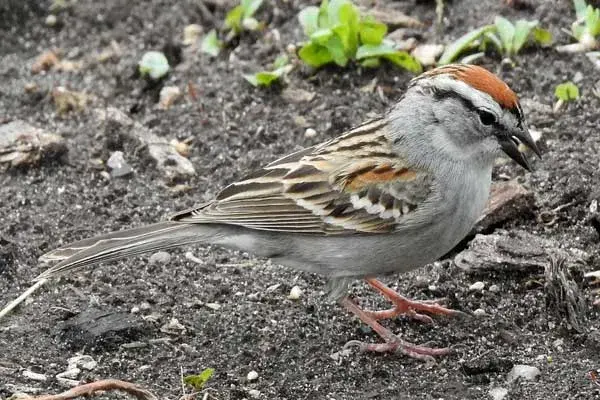
Scientific name: Spizella passerina
Lifespan: up to 9 years
Wingspan: 8-9 in
Eyebrows (supercilia): Narrow and dusky (grayish)
Found In: North America
The chipping sparrow is a small passerine bird common in gardens of North America. It has dusky eyebrows and dark eye-lines; during the breeding season, the lines above each eye become nearly white.
Chipping sparrows are delicate and active sparrows with a slightly notched tail. During the breeding season, they have a distinctive bright chestnut crown.
There are two subspecies, the eastern chipping sparrow and the western chipping sparrow.
Green Jay
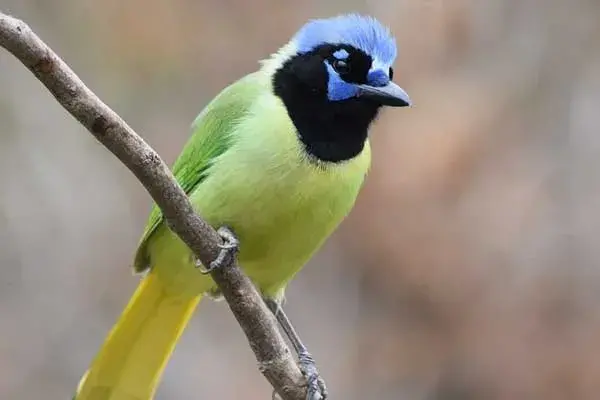
Scientific name: Cyanocorax yncas
Lifespan: 10-11 years
Wingspan: 13.5-15 in
Eyebrows (supercilia): Very short and blue
Found In: Central America
Green jays are medium-sized jays with green backs, yellow underparts, blue and black heads, and very short and blue eyebrows. They are colorful and noisy tropical birds that can be found in the Americas.
Green jays are very intelligent birds that have been seen using sticks as tools to get insects from tree bark. They got their Latin name “yncas” from the word “Inca” because the first descriptions of this species were based on birds from Peru.
A group of jays is called a “band”, “cast”, “party”, or “scold”.
Green jay is just one of 18+ on our list of birds with yellow tails. Make sure to check the article.
Blue-Gray Gnatcatcher
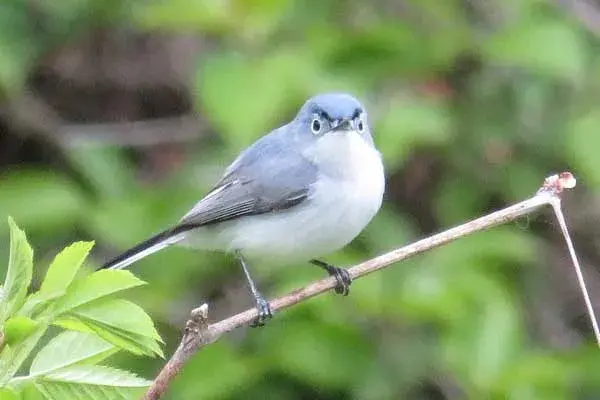
Scientific name: Polioptila caerulea
Lifespan: 3-4 years
Wingspan: 6 in
Eyebrows (supercilia): Narrow, black, and V-shaped
Found In: Central and North America
During the breeding season, male Blue-gray Gnatcatchers have a dark, V-shaped “eyebrow” marking that makes them look like they are constantly angry.
The blue-gray gnatcatcher is a very small songbird native to North America, soft blue-gray above and whitish below.
It is a monogamous bird that mates for life. Males can be particularly aggressive and will chase larger birds away from feeding areas or their nesting territory.
In summer, these small birds can be found in California, Nevada, Utah, Texas, Oklahoma, eastern Kansas, Iowa, southern Wisconsin, and the eastern United States.
Varied Thrush

Scientific name: Ixoreus naevius
Lifespan: 5-6 years
Wingspan: 13-17 in
Eyebrows (supercilia): Narrow and orange
Found In: western North America
The varied thrush is a beautiful songbird. Males have a plumage that is a combination of blue-gray, orange, and black. They also have a black breast band, orange eyebrows, and orange markings on the wings. Females are similar, but only with a duller pattern.
Varied thrushes are famous for their amazing songs – a series of loud, ringing notes that can be heard in the thick, damp, mossy coniferous forests they inhabit. They are often very aggressive toward each other, as well as other bird species.
Streak-Breasted Scimitar Babbler

Scientific name: Pomatorhinus ruficollis
Lifespan: n/a
Wingspan: n/a
Eyebrows (supercilia): Long and white
Found In: Asia
The streak-breasted scimitar babbler is a medium-sized bird with a yellow-black beak and black eyes that are cut with long white eyebrows.
It can be found in subtropical or tropical forests of Bangladesh, Bhutan, China, India, Laos, Myanmar, Nepal, and Vietnam. The streak-breasted scimitar babbler is an omnivorous bird that feeds on insects like cicadas, beetles, ants, larvae, grubs, and also seeds and berries.
Yellow-Throated Warbler

Scientific name: Setophaga dominica
Lifespan: 5-10 years
Wingspan: 8 in
Eyebrows (supercilia): Long and white
Found In: North America
Yellow-throated warblers are gray and white birds with yellow parts on the throat and black streaks down the side of their heads. Adults have a black face mask and a white eyebrow on each side.
Yellow-throated warblers can be found in open woodlands and groves, especially oaks, pines, and sycamores. They are small migratory songbirds that breed in North America.
A group of warblers is called a “bouquet”, “confusion”, “fall”, and “wrench”.
Double-Crested Cormorant

Scientific name: Phalacrocorax auritus
Lifespan: 6-17 years
Wingspan: 45-50 in
Eyebrows (supercilia): Bushy white or black
Found In: North America
Double-crested Cormorants are large waterbirds with small heads, long necks, and thin, strongly hooked beaks. When the breeding season starts, bushy white eyebrows (feathery tufts) will appear on a male cormorant’s head.
They are some of the deepest diving birds that can go around 25 feet deep underwater and stay there for up to 4 minutes.
Despite being excellent swimmers and divers, double-crested cormorants do not have fully waterproof feathers and can be seen standing on the shore, with their wings spread to dry.
The oldest documented wild double-crested cormorant lived to be almost 18 years old.
Macaroni Penguin

Scientific name: Eudyptes chrysolophus
Lifespan: 8-15 years
Wingspan: n/a
Eyebrows (supercilia): Bright, long, spiky, and orange
Found In: Sub-Antarctic and Antarctic Peninsula
Macaroni penguins are famous for their orange-gold “eyebrows”, which are actually called crest feathers. They are a species of penguin found in territories ranging from the Subantarctic to the Antarctic Peninsula.
Macaroni penguins have black upperparts and white underparts and resemble the royal penguin.
They did not get their name from the famous pasta dish but from the feathers found on hats worn by men in the 18th century that were called “macaronis“.
Read More: Do Penguins Hibernate Or Migrate?
Black Grouse
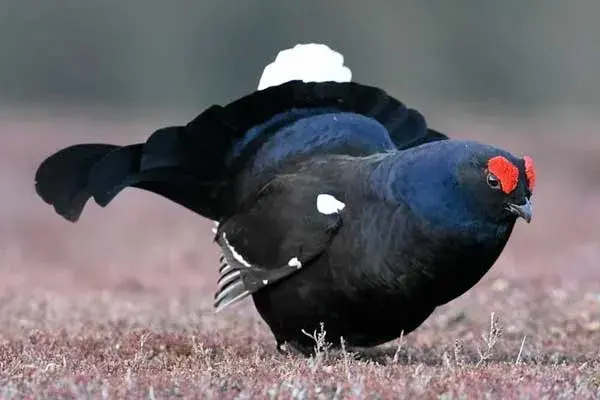
Scientific name: Lyrurus tetrix
Lifespan: 5 years
Wingspan: 25-31.5 in
Eyebrows (supercilia): Thick and red
Found In: Europe
The black grouse is a large sedentary bird. Males have all-black plumage and a distinctive red wattle over the eye that resemble thick and bushy eyebrows. They are also recognized for their tail which has a shape of a lyre and appears forked in flight.
Read More: Birds That Have Forked Tails During Flight
Black grouse can be found across Europe in groups; they migrate to dense forests in large flocks.
Eurasian Eagle-Owl

Scientific name: Bubo bubo
Lifespan: 20-60 years
Wingspan: 5-6.5 ft
Eyebrows (supercilia): Long, sharp, and pronounced
Found In: Europe, Asia, and Africa
The Eurasian eagle-owl is a species of eagle-owl that can be found in Eurasia, just as the name suggests.
It is also called the Uhu and has very pronounced eyebrows (ear tufts) and bright orange eyes.
The Eurasian eagle-owl is among the largest species of owls and an apex predator; it hunts at night using its acute hearing to locate the prey.
Rock Ptarmigan
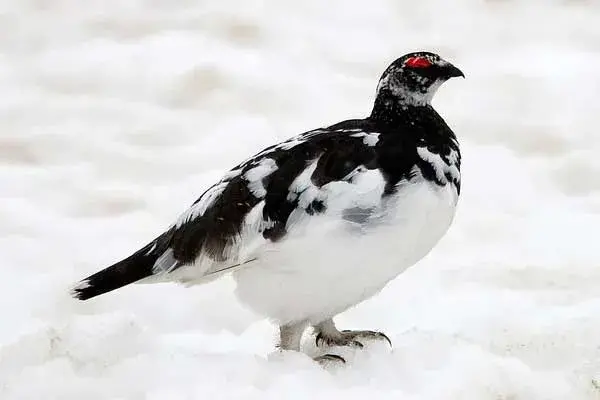
Scientific name: Lagopus muta
Lifespan: up to 11 years
Wingspan: 21-24 in
Eyebrows (supercilia): Pronounced, short, and red
Found In: North America, Europe, and Asia
The rock ptarmigan is a medium-sized game bird from the grouse family. It has a square tail, a small black bill, and feathered legs and toes to walk in the snow and stay warm. Nonbreeding males are white; breeding males have dark brown-gray upperparts and white underparts.
Rock ptarmigan breeding males have scarlet patches (“combs”) above their eyes that resemble eyebrows.
Black-Fronted Dotterel

Scientific name: Elseyornis melanops
Lifespan: up to 7 years
Wingspan: 13 in
Eyebrows (supercilia): Long and white
Found In: New Zealand
The Black-fronted dotterel is a small, slender plover with streaked upperparts, strong white eyebrows, and a heavy black line through the eye. It is easy to recognize by its distinct black face mask, forehead, and v-shaped band across the chest.
Black-fronted dotterel can be found in Australia and Tasmania, and it was self-introduced in New Zealand where it is now also common. It is an omnivore that feeds on crustaceans, insects, and seeds.
Evening Grosbeak
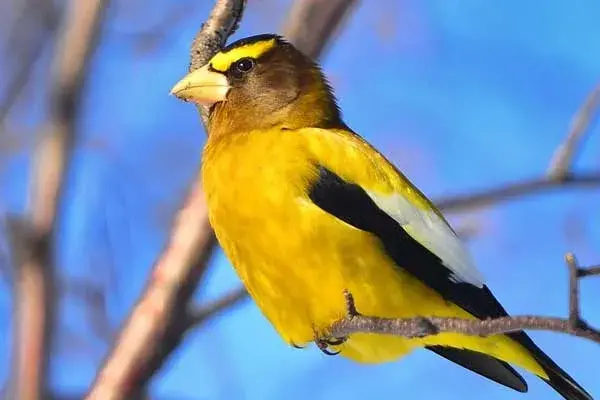
Scientific name: Coccothraustes vespertinus
Lifespan: 15-16 years
Wingspan: 12-14 in
Eyebrows (supercilia): Prominent bright-yellow
Found In: North America
The evening grosbeak is a large and stocky finch with a thick bill and neck, full chest, and relatively short tail. Males are big, mustard-yellow, have very prominent gold eyebrows, and white wing stripes.
During winter, evening grosbeaks can be seen on roadways eating raw salt and fine gravel off of the roads. They have been also seen eating almost 100 sunflower seeds in five minutes.
They are also on our list of 25+ Northern California birds.
Red-Browed Finch

Scientific name: Neochmia temporalis
Lifespan: n/a
Wingspan: n/a
Eyebrows (supercilia): Bright red
Found In: Australia
The Red-browed Finch is native to Australia and is most easily recognized by its bright red eyebrows, rump and beak, olive-green upperparts, and gray underparts. Juvenile birds do not have red brow marks.
Red-browed finches are very social animals that can be seen in small flocks of 10 to 20 individuals. They are herbivores that feed on grass and sedge seed.
White-Browed Fantail
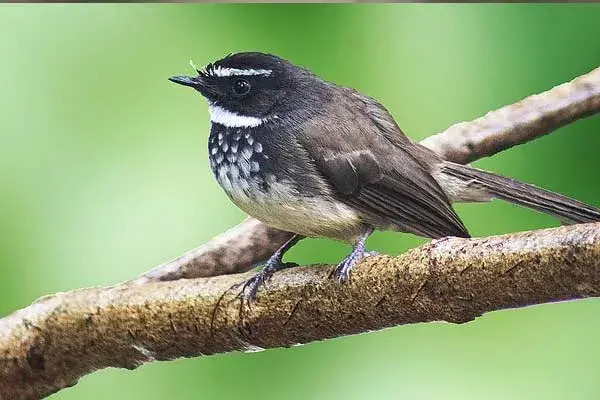
Scientific name: Rhipidura aureola
Lifespan: n/a
Wingspan: n/a
Eyebrows (supercilia): Broad and white
Found In: Asia
The white-browed fantail is a small passerine bird with dark plumage and white underparts. It has a prominent white brow and a fan-shaped tail; this makes it easy to spot and identify this bird in the wild.
It breeds across tropical forests and woodlands of southern Asia, including India, Sri Lanka, and Vietnam.
Read More: 20 examples of black birds with white wings
White-Browed Coucal

Scientific name: Centropus superciliosus
Lifespan: n/a
Wingspan: n/a
Eyebrows (supercilia): Thin and white
Found In: Sub-Saharan Africa
The white-browed coucal or lark-heeled cuckoo is a large, robust bird with rufous wings and a long, broad tail. These loud but shy birds are very hard to spot in the open. What makes it easier to identify them is a black crown and white supercilium (eyebrow line).
According to a study published by the Royal Society Publishing, white-browed coucals are monogamous birds, and both partners contribute similarly to territory defense and parental care.
Red-breasted Nuthatch
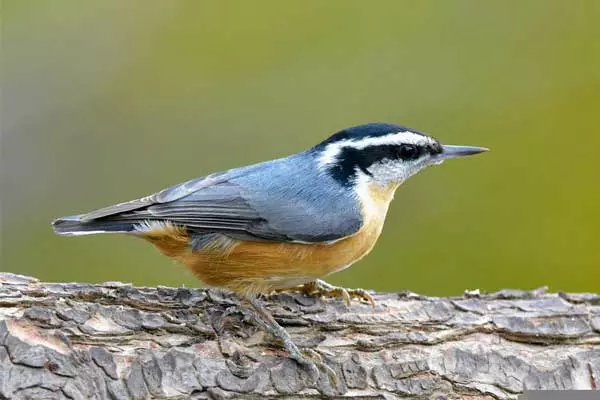
Scientific name: Sitta canadensis
Lifespan: 6 years
Wingspan: 8.5 in
Eyebrows (supercilia): Thick and long
Found In: North America
The red-breasted nuthatch is a small songbird with a long and thick white eyebrow, blue-grey upperparts, cinnamon-orange underparts, white throats, and black stripes over the eyes.
It has a straight gray beak, long toes and claws, and a black crown. It can be also recognized by its high-pitched, nasal, and weak “yank-yank” call.
Unlike their cousins, the white-breasted nuthatches who prefer living in deciduous forests, red-breasted nuthatches can be mainly seen in coniferous woods and mountains.
They mainly feed on insects and seeds, especially from conifers.
Red-breasted nuthatches will hoard excess food by wedging nuts into the bark and then hammering them in with their beaks.
Red-flanked Bluetail
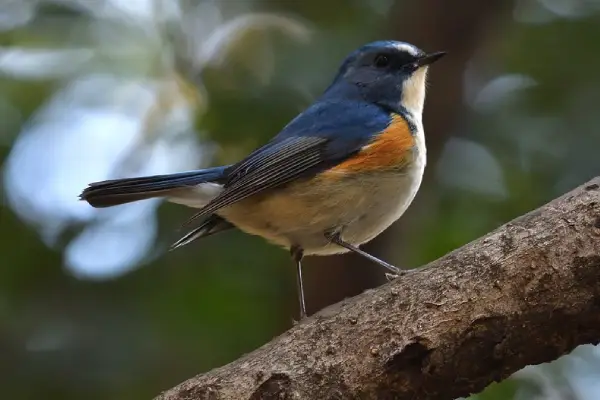
Scientific name: Tarsiger cyanurus
Lifespan: 2-3 years
Wingspan: 9 in
Eyebrows (supercilia): Small and short
Found In: Europe and Asia
Also known as orange-flanked bush-robins, red-flanked bluetails are small blue and orange birds that breed in mixed coniferous forests of Asia and Europe.
Males have a beautiful sky-blue plumage with orange sides and small white eyebrows above the eyes. Females are plain brown and both sexes have small, thin black beaks and slender black legs.
Part of their scientific name, the “cyanurus,” comes from Greek words that mean “dark-blue” and “tail”.
They are similar to common redstarts and will often flick their tails, regularly flying from a perch to catch insects in the air or on the ground.
California Thrasher

Scientific name: Toxostoma redivivum
Lifespan: up to 9 years
Wingspan: 12 in
Eyebrows (supercilia): Thin and long
Found In: North America
Common around coastal parts of Northern California, these large and long-tailed songbirds can be often seen around chaparral, oak woodland, and riparian habitats.
They are easy to recognize by their long and decurved beaks, cocked tails, and gray-brown plumage.
California thrashers also have grayish buff supercilium over their dark eyes that resemble eyebrows.
They can be often seen foraging on the ground, digging and sweeping through leaves with their bills.
During spring, California thrashers feed on insects and other small invertebrates; they might also eat some small fruits throughout the rest of the year.
California Scrub-jay
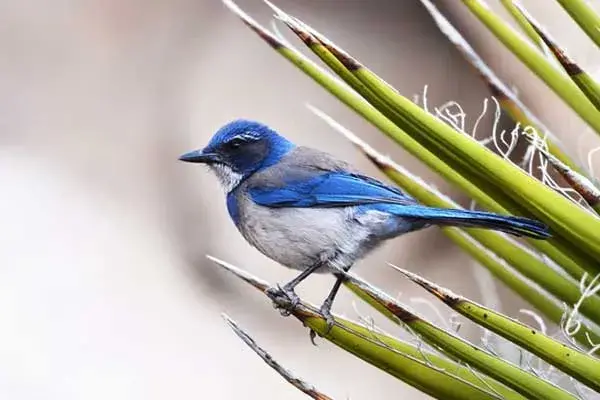
Scientific name: Aphelocoma californica
Lifespan: 9 years
Wingspan: 15 in
Eyebrows (supercilia): Thin and short
Found In: North America
The California scrub jay is an attractive bird found in parks, neighborhoods, and riverside woods near the Pacific Coast.
It is a medium-sized blue bird with deep azure blue wings and plumage and white and soft gray-brown underparts.
These birds work with other animals and can be often seen on the backs of mule deer eating ticks and other parasites.
California scrub-Jays will often steal acorns from acorn woodpeckers or other jays. When they go to hide their own acorn, California scrub-jays will check first that no other jays are watching.
They are omnivores feeding on insects, fruit, nuts, seeds, and some small animals such as lizards and nesting birds.
California scrub-jays also have a thin line above their eyes that resembles eyebrows.
Northern Goshawk

Scientific name: Accipiter gentilis
Lifespan: up to 6 years
Wingspan: 40-47 in
Eyebrows (supercilia): Thin
Found In: North America, Europe, and Asia
Northern goshawks are a species of medium-large raptor and an accipiter, a “true hawk”.
They are easy to spot by their broad, rounded wings and long tails. They also have dark heads, white eyebrows, faces, throats, breasts, and bellies. The back is blue-gray.
However, If you’re an avid birdwatcher, you will want to identify this bird from a safe distance as it is very aggressive and will swoop and attack anything that comes too close.
Northern goshawks can reach a top speed of 61 mph and will silently wait for their prey before rapidly descending down and killing it.
They are carnivores that feed on medium and large-sized birds, snowshoe hares, and squirrels. After a successful hunt, they will easily tear apart the prey with sharp claws and strong curved beaks.
This largest hawk species are monogamous, the female will lay 1 to 5 bluish-white eggs and incubate them, while the male provides her with food during that period.
Blue-black Kingfisher
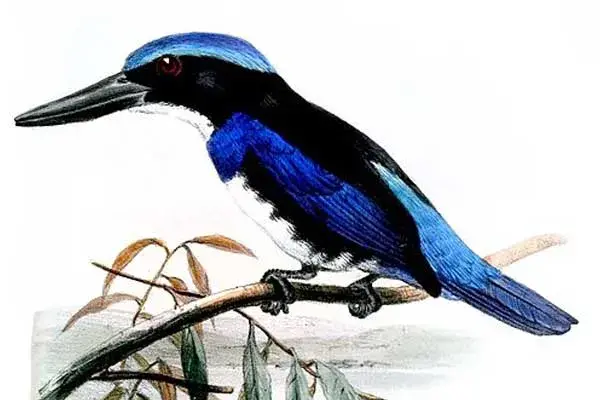
Scientific name: Todiramphus nigrocyaneus
Lifespan: 5-10 years
Wingspan: n/a
Eyebrows (supercilia): Long and pale
Found In: New Guinea
Blue-back kingfisher is a medium-sized kingfisher with a dark blue head (crown), pale blue eyebrows, black face, and pale blue back becoming darker on the rump and tail.
It is considered very rare and can be found in Papua New Guinea and adjacent islands Salawati, Batanta, and Yapen. Blue-back kingfisher is carnivorous and feeds on fish or crabs.
Purple Sunbird
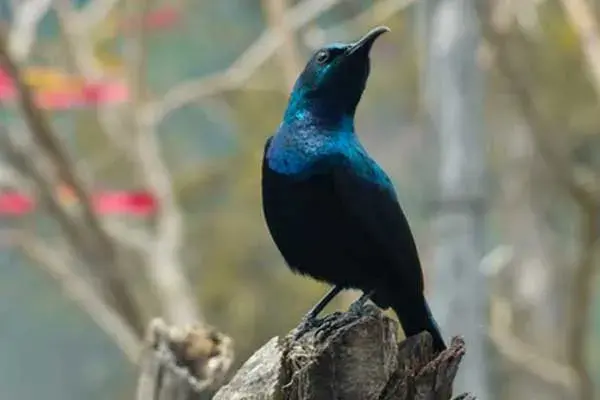
Scientific name: Cinnyris asiaticus
Lifespan: 15-20 years
Wingspan: n/a
Eyebrows (supercilia): Thin (in females)
Found In: Asia
The purple sunbird is a small nectar-feeding bird that can be found in South and Southeast Asia. It displays sexual dimorphism – males and females look different.
The breeding purple sunbird male has a plumage that may appear all black (in low light) or dark metallic blue or purplish-black in better light conditions. The head has a mostly metallic blue and purple color.
Females are olive above, yellowish below, and have a thin yellow supercilium above the eye that looks like an eyebrow.
These beautiful birds are omnivores and feed on nectar, insects, spiders, and the flesh of fruits and berries. Purple sunbirds are fast fliers and can take nectar by hovering like a hummingbird.
Final Thoughts
Despite not using their “eyebrows” as protection from debris and the sun, eyebrows still add to the looks of many birds. Some use them as part of their courtship rituals, others just because evolution decided so.
Either way, we hope you’ve enjoyed our list of 27+ birds with eyebrows, and that next time, should you meet these in the wild, you will have no problem identifying the species you saw.
Read More: 40+ birds that have orange-colored bills
List of birds with eyebrows:
- The King of Saxony bird-of-paradise
- White-Browed Wagtail
- Bananaquit
- White-Throated Sparrow
- Chipping Sparrow
- Green Jay
- Blue-Gray Gnatcatcher
- Varied Thrush
- Streak-Breasted Scimitar Babbler
- Yellow-Throated Warbler
- Double-Crested Cormorant
- Macaroni Penguin
- Black Grouse
- Eurasian Eagle-Owl
- Rock Ptarmigan
- Black-Fronted Dotterel
- Evening Grosbeak
- Red-Browed Finch
- White-Browed Fantail
- White-Browed Coucal